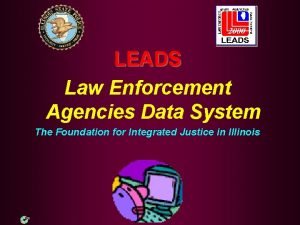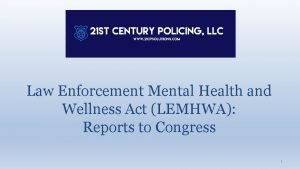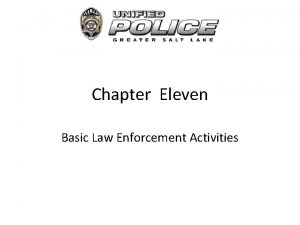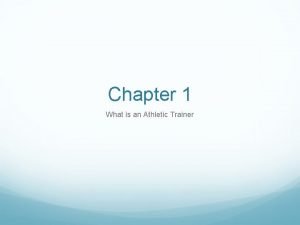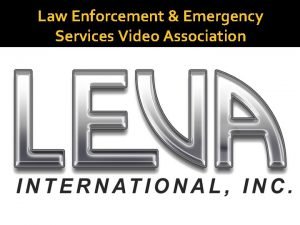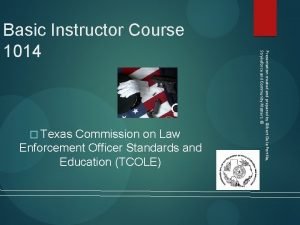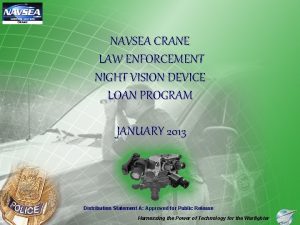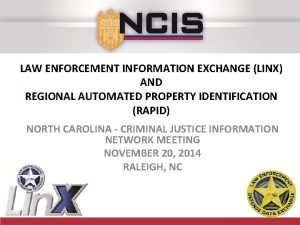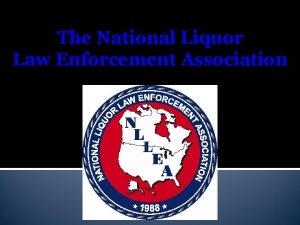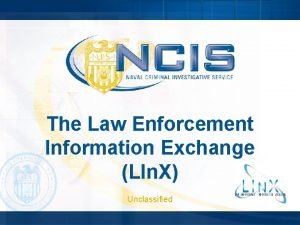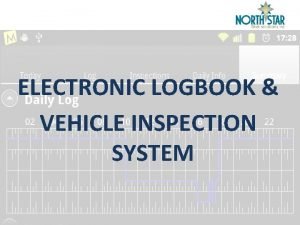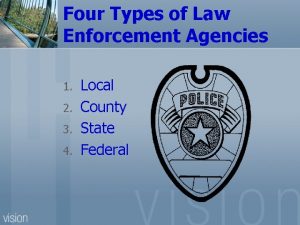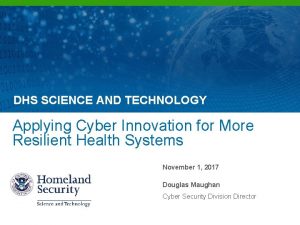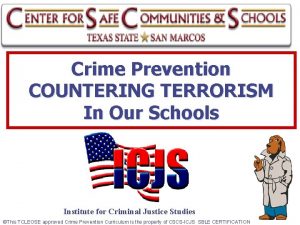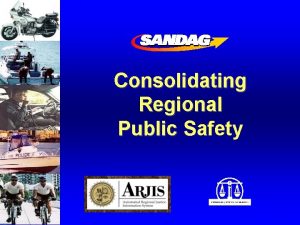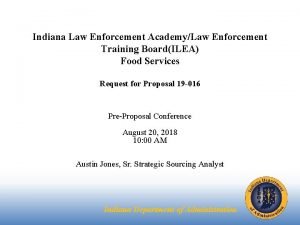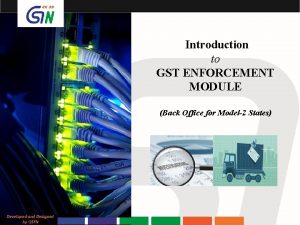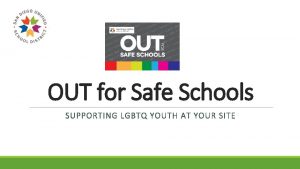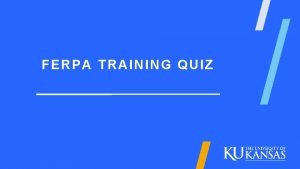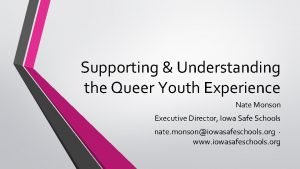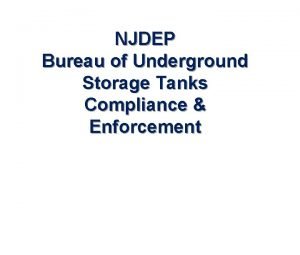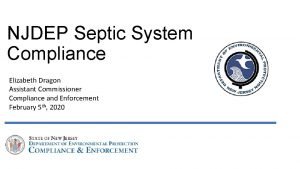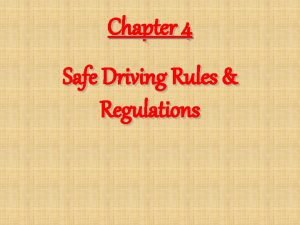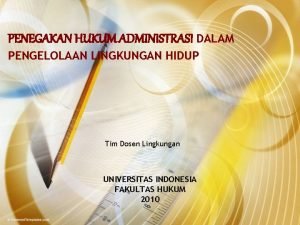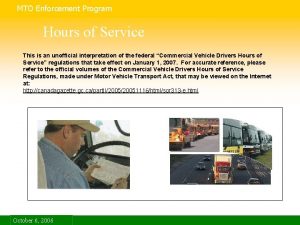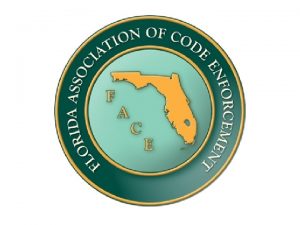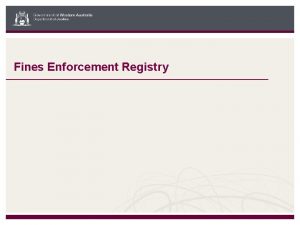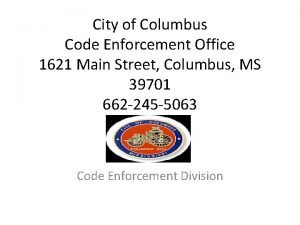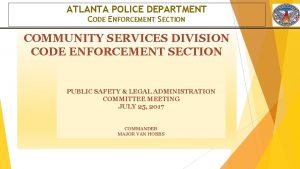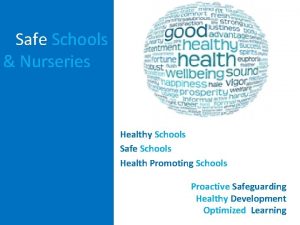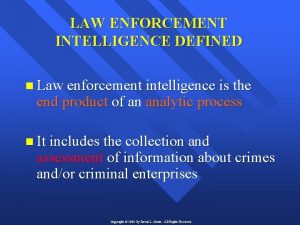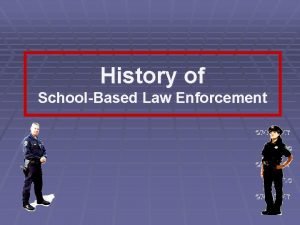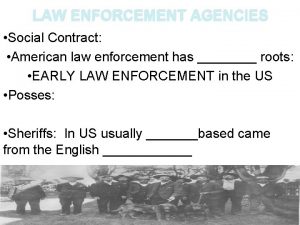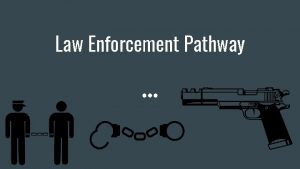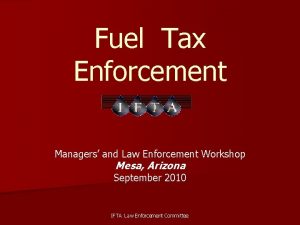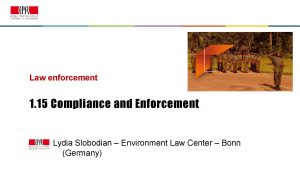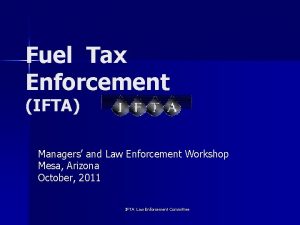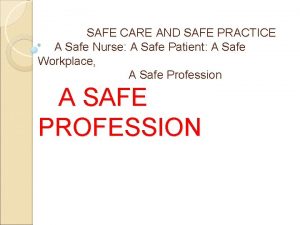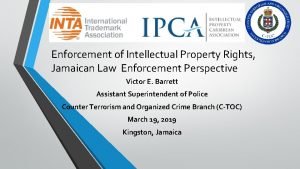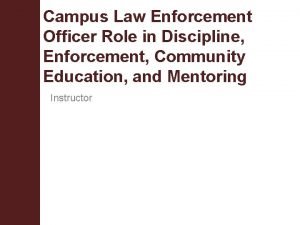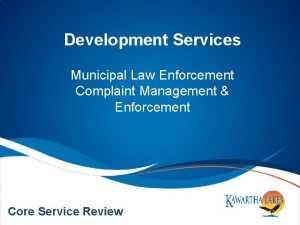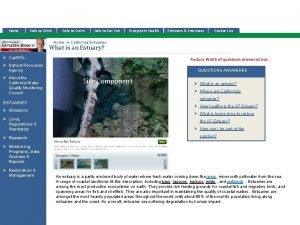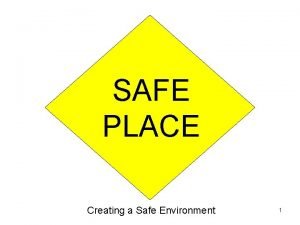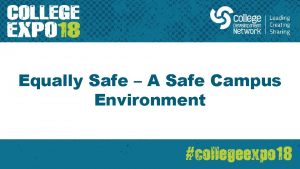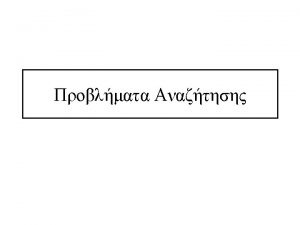Safe Schools Data Schools and Law Enforcement A






































- Slides: 38

Safe Schools Data Schools and Law Enforcement A Cooperative and Collaborative Safe Schools (PIMS)Reporting Process

Mandate Requirements • No Later than thirty (30) days prior to the deadline for submitting the report to the Office (July 31 st ), the chief school administrator shall submit the report to the police department with jurisdiction. • The police department shall review the report. • No later than fifteen (15) days prior to the deadline the police department must notify in writing whether the report accurately reflects police incident data or; • If not accurate the police department shall indicate the discrepancies between the report and police incident data.

Definition of an Incident • Incident: A specific act or offense involving one or more victims and one or more offenders. A reportable incident includes one or more acts of misconduct, involving one or more offenders violating criteria defined under Pennsylvania’s Act 26 of 1995. • These include but are not limited to any behavior that violates a school’s educational mission or climate of respect or jeopardizes the intent of the school to be free of aggression against persons or property, drugs, weapons, disruptions, and disorder. • Examples are incidents involving acts of violence, possession of a weapon, or the possession, use or sale of a controlled substance, alcohol, or tobacco by any person on school property; at schoolsponsored events; and on school transportation to and from school.

Don’t Lose Sight of the Basics ! (During the Reporting Process) • The components of a PIMS incident. • Does the details of the incident meet the criteria? • PIMS Reportable Infraction Codes • Is it a PIMS Reportable Incident, if yes identify the proper code • Understand the specific definitions of reportable crimes and infractions. • Use the definitions provided to clarify the specific crime or infraction

Best Practices (Part 1) • Cooperation, Collaboration, Coordination and Communication – Communication Process-sharing incident information – Share the appropriate parts of the PIMS manual (Volume 2) – Communicate for Accuracy • Don’t lose sight of the goal of the reporting and verification process – Accuracy – Verifiable (complete) – Timely submission • Identify and work with the same law enforcement officer(s) during the process. • Identify the team. Work with a consistent building and district level data collection and incident reporting team.

Best Practices (Part 2) • Verify the incidents with law enforcement during the course of the school year. • Work through the “gray area ” incidents to get an agreement during the course of the school year. • Don’t wait until the last minute to submit the report to the police. Stay within the 30 days. • Complete a annual team review of the process. – evaluate the effectiveness of the process – identify any changes needed to improve the process.

Consequences v Title 18 Pa. C. S. Section 4904, Relating to Unsworn Falsification to Authorities; a chief school administrator or principal of a school entity who: Intentionally fails to report or who intentionally falsifies a report shall be subject to prosecution Misdemeanor of the second or third degree v Professional Educator Discipline Act v. For a first violation $2, 500. 00 v. For a second violation $3, 500. 00 v. For a third or subsequent violation $5, 000. 00

Selecting the Appropriate Infraction Code/Crime 1. Must be based on the circumstances and details of the incident 1. May need to look beyond the face value of the incident 2. Apply the applicable Crime definition and correlating Infraction Code to the incident (Appendix Z) 1. Read the section(s) and apply the details of the incident 3. Collaborate with the local Law Enforcement Agency of Jurisdiction 1. 2. To Identify the Best Selection Working towards verification 4. Remember - You are not the Judge or Jury

Crime Clarification-Differences • Simple Assault #1, #2 • Attempts or Causes • Aggravated Assault #3, #4 • Attempts or Causes – Bodily injury – Serious bodily injury – Intentionally – Knowingly – Recklessly – Negligently cause bodily injury with a deadly weapon – Sub-Section 5 specific to schools – Enumerated positions or titles (38 total)

Crime Clarification-Difference • Recklessly Endangering another Person #23 – Recklessly engages in conduct – Which places or may place – A person in danger of death or serious bodily injury

Crime Clarification-Differences • Statutory Sexual Assault #7 – Sexual intercourse – The complainant is not married to the person – Complainant is under 16 years of age – The person is 4 years older but less than 8 years older – The person is 8 years older but less than 11 years older – The person is 11 years older – Consent does not matter • Sexual Assault #8 – Sexual intercourse – Or deviate sexual intercourse – Without the complainant’s consent

Statutory Sexual Assault (Additional) • Both under 16 years of age and the offender is four years older = statutory sexual assault and/or – Complainant under 13 years of age, sexual intercourse by a person =Rape of a child. • See page 142 of Appendix Z continuation of Infraction Code 5 (Rape), for further clarification of statutory

Crime Clarification-Differences • Institutional Sexual Assault #52 – Sub-section (a. 2) applies to Schools – A person who is a volunteer or an employee of a school or any other with direct contact with a student – Engages in sexual intercourse, deviate sexual intercourse or indecent contact with a student of the school – Indecent Contact- Any touching of the sexual or other intimate parts of the person for the purposes of arousing or gratifying sexual desire, in either person

Crime Clarification-Differences • Indecent Assault #10 – Indecent Contact with, – Causes indecent contact – Causes Indecent contact with • Seminal Fluids • Urine • Feces – Purposes of arousing sexual desire – Without Consent – Forcible – Plus other sub-sections • Aggravated Indecent Assault #9 – Penetration however slight of the genitals or anus – With a part of the offenders body for any purpose other than good faith medical, hygienic or law enforcement procedures – Without consent – Forcible compulsion – Threat of forcible compulsion

Crime Clarification-Differences • Indecent Exposure # 11 – Exposes his or her genitals – In any public place – Or in any place where there are present other persons – This conduct is likely to offend, affront or alarm • Open Lewdness #12 – Does any lewd act – He knows is likely to be observed by others – Who would be affronted or alarmed

Crime and Infraction Clarification-Differences • Fighting #17 – Mutual combat – Little to no injury – PIMS reporting 2 offenders • Minor Altercation #18 – An incident which involves a single offender who commits a minor violent act against another individual and the other individual does not respond and the incident does not elevate to a more severe type of incident such as a fight or assault. – One offender-one victim

Crime Clarification-Differences • Theft #25 – Theft by Unlawful Taking – Theft by Deception – Receiving Stolen Property – Theft of a Motor Vehicle • Robbery #24 – In the course of committing a theft – Inflicts serious bodily injury – Threat of bodily injury or use of Force however slight

Crime Clarification-Differences • Burglary #30 – Enters a building or occupied structure, or separately secured or occupied portion thereof, with intent to commit a crime therein. • Criminal Trespass #33 – Knowing he is not licensed or privileged to do so • He enters • Breaks into any building

Crime Clarification • Failure of Disorderly Persons to Disperse Upon Official Order #37 – Three or more persons – Participating in a course of disorderly conduct • • Substantial harm Serious inconvenience Annoyance Alarm – Peace Officer or public servant enforcing the law are ordered to disperse

Bullying #27 • Intentional electronic, written, verbal, or physical act, or a series of acts – – Directed at another student or students In a school setting Severe, persistent or pervasive The effect of doing any of the following • Substantially interfering with a student education • Creating a threating environment • Substantially disrupting the orderly operation of the school and school setting

Cyberbullying • Communicated through all types of electronic devices and places: – Intent to harm – Intensity and duration – Some aspect of the unwelcomed bullying or cyberbullying occurred on: – On school property – School sponsored event – Transportation to and from school or school sponsored events • Cyber Harassment of a Child #51

School Code Act 26 of 1995 and Amendments • Crimes associated with mandated reporting and further amended by Act 104 to include crimes associated with PIMS reporting. • The circumstances of an incident and the possible crimes associated with those circumstances are frequently subject to interpretation of applicable law. Law enforcement may see the crime application differently than school personnel. • A discussion needs to take place between the two parties to establish a common application. • In some cases the Law Enforcement applied crime will be different than the actual offense. • (Example) Possession of a very small amount of marijuana is Infraction Code # 47 (possession of a controlled substance) but the police charge him with disorderly conduct. The proper reporting is Possession of a Controlled Substance Infraction Code #47 regardless of the police charge.

Safe 2 Say Anonymous Tip-line • If a Safe 2 Say Tip – identifies a founded incident – which meets the criteria of a PIMS reportable incident – it will be reported with the appropriate infraction code through the PIMS Program.

Academic Code of Conduct • Location Fact Template • Infraction Code A for Academic Code of Conduct violation • Academic Misconduct: • Any action or attempted action that may result in creating an unfair academic advantage for oneself or an unfair academic advantage or disadvantage for any other member or members of the academic community. • This includes a wide variety of behaviors such as cheating, plagiarism, altering academic documents or transcripts, gaining access to materials before they are intended to be available, and helping a friend to gain an unfair academic advantage. • Only used when expulsion or suspension is a result of Academic Misconduct

Student Code of Conduct • Location Fact Template • Infraction Code C for Student Code of Conduct violations • Student Code of Conduct • Specifies behavior that is accepted or prohibited in the school as well as in any setting that is related to the school. Codes of conduct generally state the behavior expected to be demonstrated by the student. • Only used when expulsion or suspension is a result of Student Code of Conduct violation/misconduct

Scenarios

Scenario 1 • The code of conduct states, students are to be on time to school but a student has shown up late. – Is this a safe schools infraction? – Where is the line drawn? • A dress code infraction takes place during the school day – Should that be a Safe Schools Incident? – Under which code?

Scenario 2 • A student in elementary school punches some students and teachers, some of the students have received bodily injury from the violence. The student (offender) is not in or out of school suspended as a result of the incident. • Is this a PIMS reportable incident? • How would it be reported?

Scenario 3 • A student is arrested (outside of school) The incident did not occur on school property or during school hours. An educational decision is made to suspend/expel based on the outside activity. • Should this be reported in PIMS? • Other concerns

Scenario 4 • During a school cross-country sporting event a teacher is assigned to stop traffic on the school’s main driveway as the cross-country participants cross the driveway. • Having stopped some traffic, one of the vehicle operators , a non-student exits his car and verbally shouts obscenities at the teacher. A student that is also stopped in the traffic tells the irate driver not to use such language. The irate driver continues his abusive language and threatens the teacher and student. Then leaves the area. • Police are notified and provided information about the incident. • How is this handled for PIMS considerations?

Scenario 4 (Part II) • The next day, at a gas station near the school, the irate driver from the previous day sees the same student from the incident and continues to verbally abuses that student. • Police are notified and the irate driver is issued a citation for his inappropriate actions. • How is this handled for PIMS considerations?

Scenario 5 • Police responded to a suicide threat at the high school. • The student involved in the incident was last seen running from the school. • Police located the student and returned him to the high school. • The student had texted the threat to harm himself to his Mother while at school and she notified the school. • The student’s backpack was searched nothing concerning was found. • The Mother requested the student be transported for evaluation. • How is this handled for PIMS considerations?

Scenario 6 • While in the cafeteria, during lunch, at the high school, a male student is acting aggressive towards a female student and had a hold of her arm. A faculty member instructed him to stop and he complied. • A short time later the same male student was pushing the same female student and moving towards placing her into a trash can. • The faculty member placed his hand on the male student to prevent him from further pushing the female student. • The male student turned and faced the faculty member, placed both hands on the faculty member and pushed him away. • The male student was escorted to a counselor’s office • How is this reported in PIMS

Scenario 7 • An elementary student was asked to come into his classroom but immediately became aggressive and irate. • He ran laps around the hallways, ripping papers and tore a water fountain off the wall. • Police were notified as the incident unfolded • He punched several teaches and head butted another while they tried to calm him. No injuries. • This was considered “normal” behavior for this student. • He was eventually calmed • PIMS Reportable?

Scenario 8 • A former graduated student notifies police that her teacher at the middle school, 8 years prior, had inappropriately touched her while at school. • The police are investigating and have advised the school of the report.

Scenario 9 • At your elementary school a 9 year old student has been sexually touching a 6 year old student while on the school bus. This included a degree of disrobing. It was also disclosed that another 6 year old was also being sexually touched. • This was an emotional support bus. • The school was informed by a parent.

Questions

Contact Information Steve Beck Montgomery County Department of Public Safety School Safety Coordinator Montgomery County Public Safety Training Campus 1175 Conshohocken Road Conshohocken, Pa. 19428 610 -278 -3500 Ext. 6629 484 -250 -2563 sbeck@montcopa. org
 Leads provides access to
Leads provides access to Law enforcement mental health and wellness act
Law enforcement mental health and wellness act Military and law enforcement
Military and law enforcement Military and law enforcement
Military and law enforcement Law enforcement video association
Law enforcement video association Texas commission on law enforcement
Texas commission on law enforcement Law enforcement night vision
Law enforcement night vision Ncr linx
Ncr linx Virginia law enforcement assistance program
Virginia law enforcement assistance program Nllea
Nllea Law enforcement information exchange
Law enforcement information exchange Digital logbook maintenance and inspection
Digital logbook maintenance and inspection Law enforcement agencies
Law enforcement agencies Law enforcement first responder
Law enforcement first responder Law enforcement agency
Law enforcement agency Calphoto dmv
Calphoto dmv Massachusetts association for professional law enforcement
Massachusetts association for professional law enforcement Indiana law enforcement training board
Indiana law enforcement training board Gst law enforcement
Gst law enforcement Newton's first law and second law and third law
Newton's first law and second law and third law Newton's first law of motion
Newton's first law of motion Safe feed safe food
Safe feed safe food Safe people safe places
Safe people safe places Lgbtq
Lgbtq Ferpa confidentiality of records quiz
Ferpa confidentiality of records quiz Nate monson iowa safe schools
Nate monson iowa safe schools Safety reach target
Safety reach target Boyle's law charles law avogadro's law
Boyle's law charles law avogadro's law Constant of avogadro's law
Constant of avogadro's law Njdep compliance and enforcement
Njdep compliance and enforcement What is dragon assistant 3
What is dragon assistant 3 Huntsville city schools returning student registration
Huntsville city schools returning student registration Safe corridors law
Safe corridors law Second line enforcement
Second line enforcement Mto hours of service
Mto hours of service Florida association of code enforcement
Florida association of code enforcement Fines enforcement registry
Fines enforcement registry Columbus code enforcement
Columbus code enforcement Atlanta code enforcement
Atlanta code enforcement
